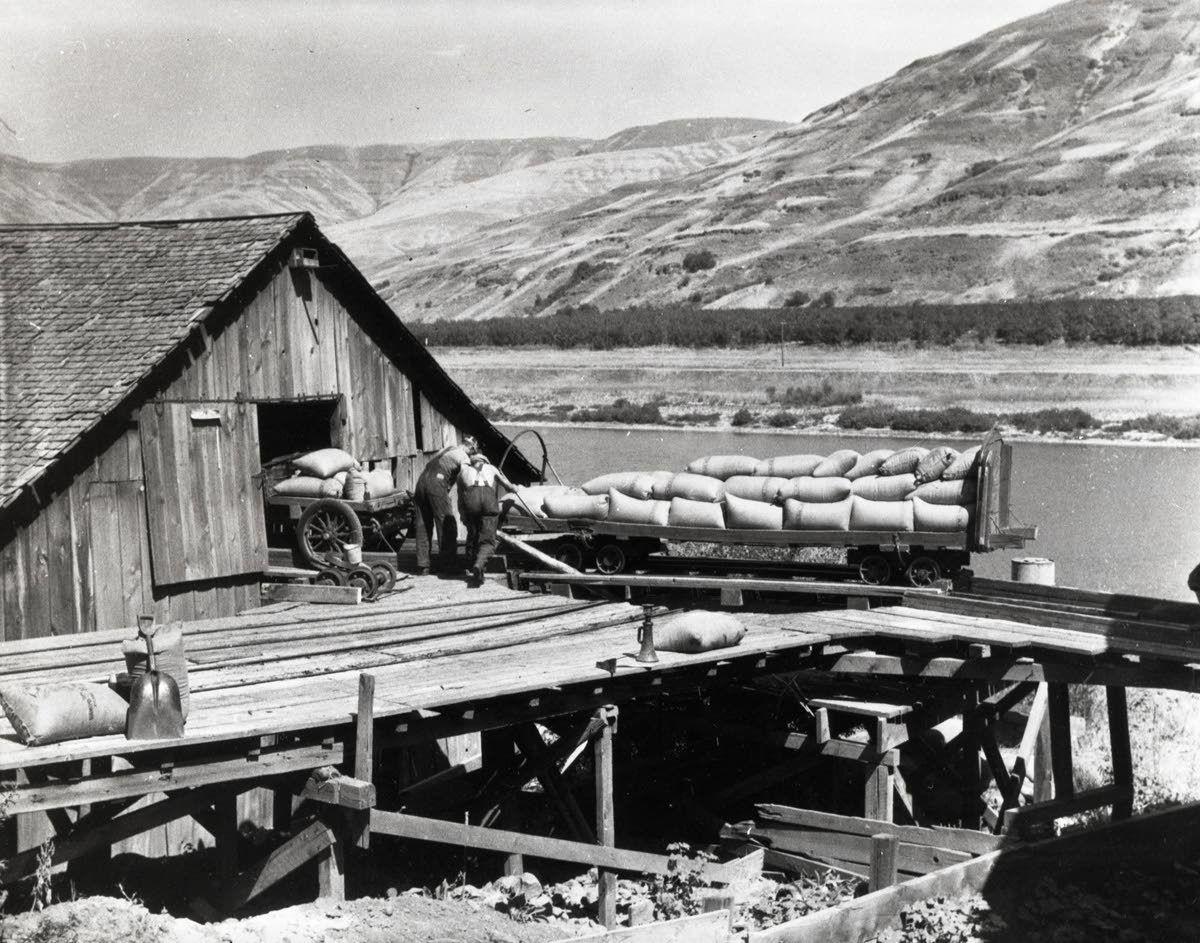forum
library
tutorial
contact

Nearby History:
The Grain Tramways of the Canyons
by Mark O'English
Moscow-Pullman Daily News, March 15, 2019
|
the film forum library tutorial contact |

|
Nearby History:
by Mark O'English
|









 Turn back the clock 120 years, and picture yourself as a wheat farmer on the Palouse, trying to get your grain to market. Trains are possible, but often distant and expensive; for many, the most profitable method is to get the grain onto the Snake River, where it could travel by barge downriver for resale.
Turn back the clock 120 years, and picture yourself as a wheat farmer on the Palouse, trying to get your grain to market. Trains are possible, but often distant and expensive; for many, the most profitable method is to get the grain onto the Snake River, where it could travel by barge downriver for resale.
However, getting grain to the Snake is difficult at best -- trying to get horse-drawn carts full of heavy grain down those slopes was both slow and risky.
At multiple places along the Snake and Clearwater rivers, farmers or businessmen built mile-long grain chutes to slide the grain down, but the friction damaged the grain, reducing its value.
In 1890, local farmers hit upon the idea of a tramway, a massive cable-based system to carry grain from the tops of the canyons down to the rivers, while simultaneously hauling the empty containers back to the top.
Documentation on these trams is often hard to evaluate, as almost no original records from the operating companies still exist. We have to rely on newspaper articles of the day, and on stories collected decades later by histories from those who worked them.
That said, there appear to have been at least six wheat tramways on the Snake and Clearwater rivers, most operating from the 1890s or 1900s into the 1930s and '40s. There were other, smaller tramways -- Washington State College used one to move coal from railroad tracks up to its power plant before finally building its plant down next to the tracks; one in Joel transported clay down to the railroad; and trams in Kendrick and Juliaetta moved wheat from the plains down to the towns. Various regional mines and lumber facilities used trams to move their product.
We're focusing today on the wheat-based trams on our rivers.
At least six trams ferried grain down to the Clearwater and Snake rivers, with all but the farthest downstream, the Interior Tramway, servicing the farms on the south side of the rivers. Starting with the farthest upstream, the Kooskia Tramway ran from a rocky point six miles east of Winona down to Kooskia. The next ran from six miles north of Nezperce to the long-vanished Tramway Station, a mile upstream of Pardee; it appears to have carried at least four different names: Culdesac, Nezperce, the Tramway Tram and Pardee. Continuing downstream, the last on the Clearwater was the Lenore Tramway.
Moving on to the Snake, you'd come to the Judkins Tramway, ending not far downstream from Nisqually John Canyon. Next was the Mayview Tram, which ended about a mile upstream from the current Wawawai Park. Finally, you'd come to the Interior Tramway, named for the Interior Warehouse Co., which ended about a mile below Wawawai Park.
Five of these six trams were of the "bucket tram" variety, basically running elevated ski chairs, though predating the ski lift by several decades. Each was a single long loop of cable, onto which was hung some type of carrying container.
Grain, initially bagged but later loose, was loaded into these "buckets," and their own weight would carry them down to the bottom while simultaneously pulling the empties back to the top. A brakeman would ride herd at the top, controlling the rate of descent. Most of these tramways had no power whatsoever, relying solely on gravity to run them; a few used engines to start the trams moving but would run on gravity thereafter.
The sixth tramway, the Mayview Tram, was a ground-based rail line. Also the oldest of the six trams, rather than a loop, it was simply two rail cars on one long cable -- workers would load one car at the top and drop it down the hill; the connecting cable would pull the bottom cart up the track as the top cart dropped. It required double tracks only at the middle, where the two carts would pass each other.
While photos exist of many of the trams, actual film footage, taken in 1938 by WSU grad student Norman Longhurst, of the Mayview Tram in operation still exists and can be seen today online.
Estimates of the length and heights of the tramways vary, but most were anywhere from 1 to 1 1/2 miles in length, and dropped as much as 2,000 feet in altitude. With few records surviving, it is difficult to put a number on the total amount of grain moved; one estimate puts Whitman County's Interior Tramway alone at moving 1.1 million bushels of grain over its lifespan.
As modern highways came into existence, the cost-effectiveness of the tramways decreased. Some of the trams went out of operation in the 1920s, most of the rest in the 1930s, and the last to go was the Mayview Tram, which closed in 1942. Parts and pieces were scavenged over the years, most notably when the Pullman Junior Chamber of Commerce hauled away the full 2 miles of the Interior Tramway cable for war scrap in 1942. For the trams on the Snake, any surviving pieces at the river level were submerged in the 1970s when the dams went in. Today, only scattered timbers and other pieces remain on the hillsides to mark the fading presence of the once-vital tramways.
learn more on topics covered in the film
see the video
read the script
learn the songs
discussion forum
